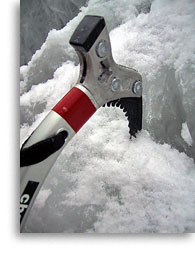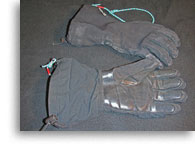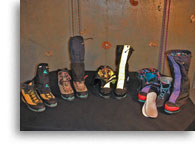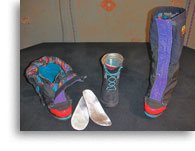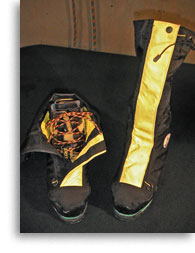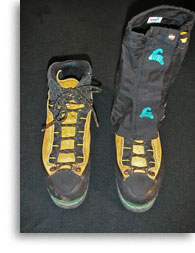
|
Ice Equipment |
|
|||||||||||||||||
|
We provide all technical gear such as ropes, harnesses, helmets, crampons and ice tools. We can also provide climbing packs for use in our day-long programs. You need only provide appropriate clothing, footwear and personal accessories. If you already own some of these items, and you wish to use them, feel free to bring them along. For our overnight trips, we provide all group gear such as tents, stoves, cook sets and emergency equipment; you will need to provide your own sleeping bag, pad and pack. In some mountain environments, clothing can be as important to your safety as a rope. Please visit our Equipment page for an in-depth discussion of technical clothing. Included are topics on: heat and moisture management, outdoor fabrics, fit considerations for clothing and footwear, purchasing suggestions, and much more. If you are not very familiar with specialized outdoor clothing we suggest you carefully review this page. |
|
|||||||||||||||||
|
In the section below, we have tried to give you a range of choices to help guide you in the acquisition of equipment and specialized clothing. There is no one “best way” to outfit yourself and cost will inevitably enter into your purchase decisions. Our opinions regarding the best equipment and clothing for any given purpose are based upon our experience using the equipment extensively in the Adirondacks. When we travel away from this area our choices are sometimes different from what we present here. Clothing For Ice Climbing APPROPRIATE CLOTHING IS ESSENTIAL FOR YOUR COMFORT & SAFETY!!! Wicking Layer Insulating Layer Outer Layer (Shell) SOFT SHELLS: We wear soft shells whenever we ice climb. Most of the time these comfortable, and very breathable, garments are sufficient on their own as outer layers. They do a great job of protecting against wind, snow, light rain and spray on wet climbs, but they are neither water “proof” nor wind “proof”. When it's really nasty we will (reluctantly) wear our hard shells over our soft shells to keep the elements at bay. Many companies manufacture soft shells and several fabrics are now used in addition to the original one made by Schoeller. These garments are available in light and heavy weights and we find both to be useful. Hoods are nice for extra warmth at belays. Get ready for sticker shock — comfort comes at a price. HARD SHELLS: These will protect you under the harshest conditions. We use hard shells only when we must but we carry them in our packs most of the time just in case we need to wear them over our soft shells. There are many waterproof-breathable, hard shell garments on the market and most work quite well. We like the lighter weight fabrics but heavier fabrics are tougher and we wear them when abrasion is likely to be an issue. We often wear a soft shell and carry a light Waterproof/breathable hard shell in case conditions demand it. We prefer an anorak (pullover with a built-in hood) on top and pants (not bibs) on the bottom because they work well in conjunction with a climbing harness, and they allow good freedom of movement. Jackets and bibs are satisfactory but may be less convenient. Side zips are a convenient feature on pants, but not required. Coated, or non-coated, nylon jackets and pants are passable substitutes if you need to save a significant amount of money. A ski jacket and pants will also work as a last resort. An extra insulating layer can help offset an inferior outer layer. |
||||||||||||||||||
|
Head and Hands Keeping your hands warm while ice climbing is invariably a compromise; with mittens you might have warm hands but you won’t be able to handle equipment well; with gloves you can feel your ice tools only if your hands have feeling. Our solution is to rely on gloves exclusively and carry a spare pair (or more) in our packs “just in case”. |
|
|||||||||||||||||
|
Modular ice climbing gloves with removable liners are the best choice for cold conditions. These gloves are constructed with a gauntleted shell of waterproof fabric and a tough palm. The fingers are cut curved so that it is easier to grip an ice axe (or ski pole). They include plenty of insulation and some models are padded to protect your fingers if you accidentally whack them on the ice. These gloves have changed ice climbing so dramatically that we consider them to be almost essential and they are the very first piece of “clothing” you should acquire. Several companies manufacture these gloves and they are marketed specifically for ice climbing. To be effective for really cold conditions, gloves need to be large enough so they can become a makeshift mitten to warm your fingers – without removing them. This is accomplished by sliding your fingers back into the palm area of the glove and forming a fist so your fingers can warm each other. Gloves need to be large enough so you can do this without difficulty using one hand and maybe your teeth. Insulation technology is FAR less important to warmth than the ability to ball your fingers up and warm them. If you can’t get a pair of ice climbing gloves, we suggest you bring a pair of ski gloves plus a pair of mittens. We can loan you gloves if needed. All gloves and mittens should be equipped with idiot (retainer) cords, which we’ll be happy to set up for you. A spare pair of glove liners and/or warm mittens can be a very welcome addition for cold or wet days. On warmer days we wear a variety of lighter weight gloves that permit greater dexterity but are not as warm as the gloves we wear most of the time. Many of the expensive single-layer gloves marketed specifically for ice climbing fit into this category and they are wonderful when conditions permit. In the Adirondacks however, our often cold temperatures require the use of warmer gloves most of the time. Eye Protection Substitutions |
||||||||||||||||||
|
Footwear For climbing steep ice in winter, plastic double-boots – with an insulated inner boot and a plastic outer boot – have served climbers faithfully since the 1970’s. The best quality plastic double-boots are very warm and most ice climbers eventually end up owning a pair because they perform well in the coldest conditions. Several companies make boots that fit into this category. Most also make plastic double-boots intended for summer conditions and these boots lack the insulation needed for comfortable ice climbing in winter. We suggest you consider only the winter models if you are planning to purchase plastic double-boots. You may wish to rent a pair of these boots from us if you do not have your own or, so you can try them out before making a purchase. Many manufacturers produce specially-designed models of single-boots for ice climbing. The inner boot and outer boot can not be separated with a single-boot. Some of these boots are leather, others are synthetic and many combine materials. These boots are lightweight, precise and a joy to climb in, but (and this is important) they are not as warm as a good winter plastic double-boot. We love to climb in our single-boots, but when the temperature drops below zero (Fahrenheit) we are very glad to have the extra warmth our double-boots provide. Like double-boots, ice climbing single-boots vary considerably and the winter models are not always obviously different from those designed more for summer glacier travel. Because we climb in single-boots most of the time we use several models, depending upon the temperature and the type of climbing we plan to do. Some are very light and precise; ideal for difficult mixed climbs when the temperature isn't too cold. Others are better insulated and not quite so precise. Most people are not willing to invest in four or five pairs of very expensive ice climbing boots so we suggest you go one of two routes: either buy a pair of warm plastic double-boots for cold days plus a pair of fairly light single-boots to use the rest of the time or; buy one pair of well-insulated single-boots and stay home (or rent boots) when it’s really cold out. If you already have a pair of plastic double-boots designed for summer mountaineering, or a pair of summer mountaineering single-boots (with a rigid sole and a Norwegian welt), these can be stretched into four-season service with an insulated supergaiter, but we would not suggest buying this type of boot for ice climbing. Remember, despite their outward appearances being quite similar, winter and summer boots are quite different and the summer models will not keep your feet as warm. Other types of footwear are useless for ice climbing. Regardless of the boot type you choose, it must have a welt in the front and rear so it can be used with step-in crampons. We fit our boots wearing a single heavy sock, and we specifically suggest you avoid using liner socks. Darn Tough, Thor-Lo, SmartWool, and other companies make socks that both wick and insulate well. With just one sock there’s no liner to slip down and bunch-up, causing discomfort and possibly blisters. Clean socks are important too. If we plan to be out for more than one day, without changing socks and thoroughly drying our boots, we use a vapor barrier sock – but otherwise we avoid them because they are not particularly pleasant to wear. Fitting boots for ice climbing can be tricky. Boots that are too tight will be cold because they will limit blood circulation in your feet. Boots that are too loose will flop around and climb poorly – and may cause blisters. You need to find a boot that fits the SHAPE of your foot, and one that is the right SIZE. Heel-lift and pressure points are indicative of a bad fit, as are boots that are too wide or narrow. You should try boots from at least two different companies to get a sense for how boot shapes can vary. We wear the same thickness and type of sock in all of our winter footwear, so fit is not altered by the “wrong” sock – and we never add socks to adjust fit. We fit our warm double-boots with an extra insole (or two), and we keep the fit slightly on the loose side for warmth. We fit our single-boots more snugly (but never tight) to enhance precision. Expect to spend a minimum of one hour fitting boots, much longer if your foot shape is at all challenging. Gaiters should be used with all boots and it is important that the gaiter fit the boot properly. There are two types of gaiters. Supergaiters fit over the entire boot upper, covering down to the welt. These can be insulated or un-insulated and they are warmer than conventional gaiters which cover the top of the boot only. Gaiters for most Adirondack ice climbing should cover the lower- leg up to the knee. Shorter gaiters are nice on summer glaciers or in spring snow conditions, but they can allow deep, soft snow to enter your boots – not good. If you have boots other than the warmest plastic double-boots we suggest you use an insulated supergaiter with a rubber rand most of the time. If you have top quality plastic double-boots a conventional gaiter will suffice, but we sometimes use an insulated supergaiter anyway. Waterproof- breathable fabrics don’t help much for ice climbing gaiters; we prefer ballistic or cordura nylon for their durability. We have a limited number of ice climbing boots (with gaiters) available on first-come first-served rental basis. If you are considering this option you should check with us regarding size, availability and cost. |
|
|||||||||||||||||
|
Equipment For Following Ice Climbs Climbing Harness Belay Device Locking Carabiners (2) Nut Tool Non-Locking Carabiners (2) Long & Short Prusik Loops Cleaning Sling Helmet Klettersack Suggested Reading We maintain a small selection of books available for sale, including this one. |
||||||||||||||||||
|
~ Mountain Adventures In the Adirondacks Since 1985 ~ |
|||
|
Alpine Adventures, Inc. |
(518) 576-9881 |
||
